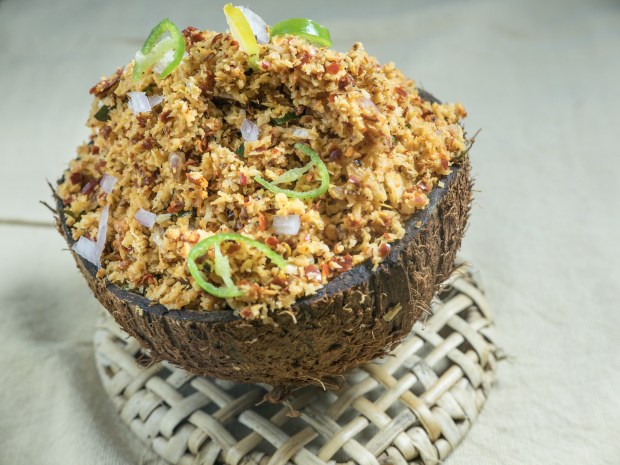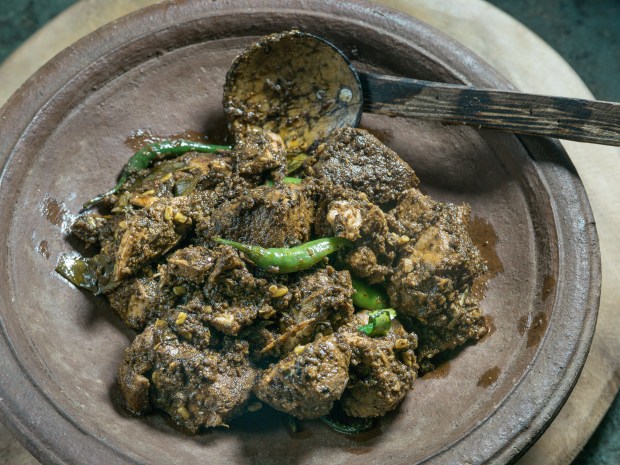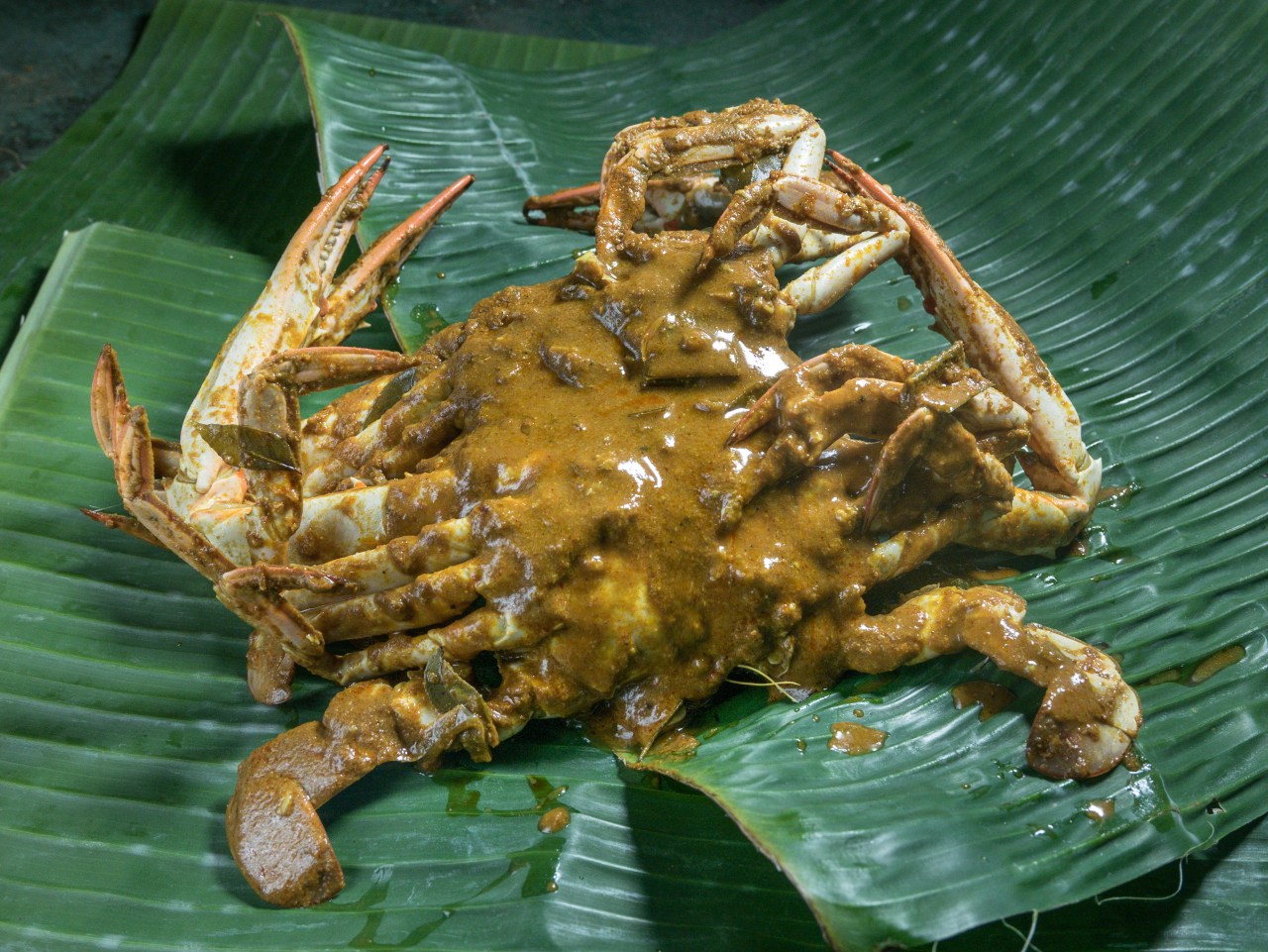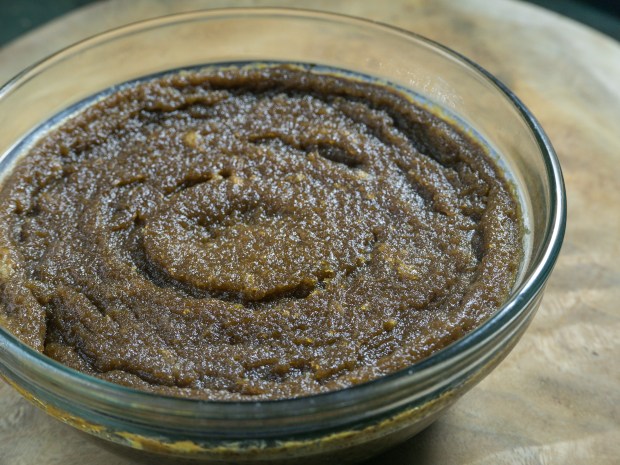It was a humid July afternoon in Colombo, only a couple of weeks after I arrived in the city as a bewildered expatriate from Mumbai. Still finding my sea legs and longing for home, I found comfort unexpectedly in a bowl of brick-red curry. Spicy enough to make my eyes water, the curry piqued my curiosity. It was laden with chunks of a fruit that tasted like a cross between green mango and pineapple, with thorny pits thrown into the mix as well. After an afternoon of feverish Googling, I learned that the fruit was the hog plum, locally known as ambarella. Armed with this newly acquired nugget of knowledge, I felt like I had finally found a toehold in a cuisine—and culture—quite different from my own.
Over time I have learned that although Sri Lankans are a reticent lot, there is no better gauge of their generosity than a typical rice-and-curry lunch. At its most extravagant, this meal could include half a dozen vegetarian curries, a couple of meat curries, sambols, fried chilies and papadum. Even a bare-bones lunch is considered incomplete without three or four distinct components. Although a meal of so many individual elements can seem like an overwhelming rush of color, texture, and flavor, it is a true representation of the complexity of Sri Lankan cuisine.
Based on a bedrock of spices—masterfully blended in roasted and unroasted curry powders—Sri Lankan cuisine celebrates bold flavors. Yet the searing heat of a Jaffna-style crab curry is usually foiled by a creamy coconut-milk gravy; and the slight sourness of a lacy appa (or hopper) is elegantly offset by the jamminess of seeni sambol, with its caramelized onions and chili. Sri Lankan cooking strikes a perfect balance—and it does so with particular flair and finesse.
Although it is best enjoyed as a composite, here are some individual dishes worth seeking out.
Pol sambol
Although sambols—freshly prepared, usually uncooked condiments—are an integral part of every meal in Sri Lanka, there is no sambol as popular as pol sambol. Pol is the Sinhalese word for coconut, and this sambol puts the island nation’s most ubiquitous ingredient to excellent use.

Freshly grated coconut is pounded, usually in a stone mortar and pestle, with red onion, dried chili flakes, salt, and lime juice. The lime juice moistens the shredded coconut and adds a bright tanginess to this spicy sambol. Occasionally, you might also find flakes of Maldive fish (dried and cured tuna flakes) in your pol sambol. Traditionally produced in the Maldives, Maldive fish adds a distinct umami depth to many Sri Lankan dishes.
As far as condiments go, pol sambol is a versatile one, pairing perfectly with a variety of carbs. I like it best for breakfast, scooped up with a hopper or adding a little jolt of spice to pol rotti, rustic flatbreads made of refined flour and grated coconut.
Ambul thiyal

The first time I tried ambul thiyal, I wasn’t prepared for how it would make my tongue curl. That intense pucker is the hallmark of a good ambul thiyal, or sour fish curry, a specialty of southern Sri Lanka. Although you will find several kinds of fish curry in the seafood-loving country—ranging from fiery to mild and creamy—ambul thiyal is utterly unique. Large chunks of tuna—or other firm, oily fish such as mackerel—are basted in an intense marinade of spices like black pepper, cloves, cardamom, cinnamon, and red chili flakes, then cooked in a clay pot with a little water until they dry out. The ambul, or sourness, comes from a star ingredient—a sour tropical fruit called goraka, or Malabar tamarind, which lends the curry its characteristic sharpness and deep color.
Originally developed as a rustic way to preserve fish in the prerefrigeration era, ambul thiyal has become something of a delicacy in modern Sri Lanka. It may not feature very often in everyday meals, but that’s not surprising. A complex creation made from simple ingredients, it is the sort of dish that demands—and deserves—reverence.
Jaffna crab curry
Before you tuck into the signature crustacean curry from Jaffna, the capital of Sri Lanka’s northern province, remember a few ground rules: Roll up your sleeves, keep a stack of tissues handy, and be prepared to get your fingers dirty. There is no dainty way to eat this Scoville-defying curry—simply persevere and you will be rewarded with an endorphin rush after.

Jaffna crab curry might be the best showcase of the cuisine of northern Sri Lanka, which has been shaped by its unique geography. While the region is rich in seafood from the waters of the Bay of Bengal, its dry, arid climate means that there is limited access to the tropical riches of the rest of the island. Although it has an astonishingly complex flavor—numbingly fiery with a touch of sweetness—Jaffna crab curry is made of humble ingredients such as mustard seeds, green chilies, black pepper, and fennel seeds, which are ground together to make the flavor base for the tamarind-laced gravy. A few sprigs of murunga (drumstick) leaves are added for texture and a bit of bitterness.
I like to eat Jaffna crab curry with a big loaf of kade paan, or crusty white bread, which soaks up the gravy and tempers the intense burn.
Hot butter cuttlefish

Hot butter cuttlefish (HBC for short) is Sri Lanka’s gloriously golden, unabashedly deep-fried contribution to the world of bar food. A paean to greasy excess, it consists of round slivers of cuttlefish—a mollusk closely related to calamari—coated in an egg-and-corn-flour batter and deep-fried before being flash-fried in butter with spring onions and chili paste. A riot of crisp, chewy, and crunchy textures, hot butter cuttlefish is the foremost ambassador of Sri Lankan Chinese food, that is, Sri Lanka’s imaginative spin on Chinese food, modified to please local palates.
Over time Sri Lankan Chinese food—and hot butter cuttlefish in particular—has become intrinsic to the country’s bar culture. In Colombo bars of all stripes unfailingly feature HBC on the menu—and for good reason. Order a glass of smooth, locally brewed coconut arrack and chase it down with a plate of fresh-off-the-fryer hot butter cuttlefish. You will understand why HBC is so wickedly perfect.
Watalappan

A tropical twist on a custard pudding, watalappan is the decadent legacy of Malay immigrants to Sri Lanka. The steamed pudding is made of coconut milk (occasionally combined with condensed milk), eggs, cashews, and jaggery (unrefined palm sugar), with cardamom and cloves for fragrance. Made right, watalappan has a springy texture and a caramel sweetness that pairs perfectly with the gentle flavor of coconut milk. In a country that favors cake over indigenous desserts, watalappan is an honorable exception.